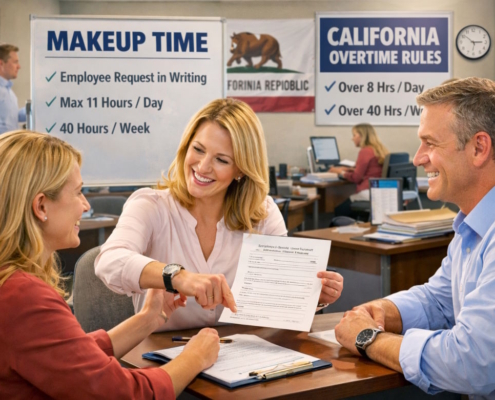How are exempt and nonexempt employees different?
A lot of states have labor rules that separate types of workers based on how they do their jobs. California is one of those states. In California, there is a distinction between exempt and nonexempt workers in relation to their responsibilities and compensation. Depending on these distinctions, an employee may be subject to different federal and state labor regulations, such as those dealing with meal breaks, paid time off, and overtime compensation.
Without further ado, let’s get to it.
What factors determine if a position is exempt or nonexempt?
Several elements determine if a job is exempt, the most important of which are salary, employment title, and work tasks. For employment in California, there are clear legal boundaries between exempt and nonexempt positions.
1. Limits on salary
In order for a position to be considered exempt, California establishes a minimum salary. In general, jobs in California that yield less than $58,240 annually are considered nonexempt. The amount is calculated by multiplying the state minimum wage of $14 per hour by 52 40-hour workweeks. It is current as of January 1, 2021. For businesses employing a maximum of twenty-five workers, the limit is set at an annual $54,080.
Similar to the other standards used to determine which jobs in California are exempt and which are not, this regulation is not ironclad. Employers and the California state labor commissioners might use it as a benchmark to determine where a certain job stands. It is common practice to consider all relevant circumstances impacting the worker’s position before making the ultimate exemption judgment.
2. Job titles
Under California law, certain occupations are more likely to be exempt than others. Generally speaking, lower-rated jobs are less likely to be exempt than job titles suggesting management or senior supervisory roles. The so-called “white collar” exemption often applies to occupations in executive, administrative, management, and other professional roles, however this is by no means an all-inclusive list.
3. Positions in executive management
In most organizations, the highest-ranking individuals are known as executives. Large organizations often have hundreds of top-level personnel who are exempt, while many small and medium-sized businesses have at least a handful. Within the state of California, executive roles are almost generally considered to be exempt positions. Executive positions often include the following:
- CEO
- COO
- CFO
- Vice President of [division]
- Board Member
- Director
- Manager or Director at the Regional, National, or International Level
- Administrative titles
Administrative responsibilities can range greatly from one organization to another and from one profession to another. However, under California labor law, many administrative positions are regarded as exempt. Among the most common administrative job titles that are exempt are:
- Personal Assistant
- Executive Secretary
- Administrative Assistant/Director/Manager
- Senior Assistant
- Professional titles
Most of the time, professional personnel are exempt. For labor relations reasons, nearly all professional occupations are considered to be equivalent to executive and senior management positions, with a few notable exceptions. Some job titles used in the professional world are:
- Lawyer
- Consultant
- Doctor
- Senior Accountant
- IT Manager, Webmaster, Database Manager
While most professional occupations are exempt, it’s not always wise to base your eligibility assessment just on the job title. To be sure if a certain position at your organization is likely to be exempt or not, it is always a good idea to consult a labor law expert.
4. Terms of employment
There are several occupations that are virtually always considered to be exempt. A number of self-employed people fall under this umbrella, most notably:
- Freelance workers
- Outside sales professionals
- Independent contractors
- Some tech and IT jobs
Employment in these areas is often thought to be exempt, however there are always outliers. Don’t rely on a job description or title without consulting an expert on labor law.
In California, what are the rights of exempt and nonexempt workers?
In California, there are distinct rights and obligations for exempt and nonexempt positions. In addition to influencing the nature of the task, this factor can significantly impact how the job is classified.
It is not uncommon for California labor commissioners to consider perks and other intangible aspects of work when deciding on a final categorization in borderline circumstances, such as occupations with unclear descriptions or no defined employment conditions.
Ultimately, the categorization choice is not going to be influenced by any one element. Rather, before making a final decision, the labor commissioner often takes into account every relevant factor and balances pay, benefits, and paid time off. Because of this, the system for paying employees, the frequency of paychecks, and the amount of money they get all important. The degree of supervision an employee needs and the specific duties assigned to them are two other important considerations.
Salaries vs. hourly wages
When determining if a worker is a California exempt employee, one of the most important factors is their pay rate. The vast majority of hourly workers are considered nonexempt, although a large number of salaried workers enjoy some form of exemption. Of course, there are exceptions to this rule. Although some exempt workers receive hourly compensation, this does not mean that all salaried workers are exempt.
Depending on the specifics of their pay plan, an employee whose job duties normally qualify them as an exempt worker may instead be labeled a nonexempt worker. While this has nothing to do with a worker’s salary per se, it does have to do with whether or not their compensation is hourly.
A supervising employee may be assumed to be in an exempt position if, for example, they receive a fixed weekly income of $2,000. However, the position could be considered nonexempt if the employee takes half a day off every other week and their pay is reduced by 10% to compensate. This is because it is assumed that the pay reduction is related to the hours worked instead of the total work product.
Differences between white-collar and non-white-collar work
There are two main types of jobs in America: blue collar and white collar. Even while there isn’t a universally accepted definition, white-collar work often involves sitting at a desk all day whereas blue-collar work often involves physical labor.
The word “blue-collar” encompasses a wide range of occupations, from transportation to physical work to operating heavy machinery. Blue collar workers include numerous entry-level workers, as well as many office workers whose duties involve some physical labor or who are located at lower levels of the organization’s structure. The variety of blue-collar employment makes broad generalizations about them challenging. However, in California, any job that fits this description is probably not exempt.
The line between blue-collar and white-collar jobs is already blurry. CEOs, attorneys, academics, senior and intermediate managers, receptionists, and customer service representatives are all examples of white-collar workers. Although white-collar jobs are more likely to come under the exempt category, companies in California should exercise caution when deciding which jobs are exempt and which are nonexempt based on this distinction alone. Since many people who would normally be classified as white-collar workers are not, this differentiation serves just as a general framework for categorization.
Autonomy vs. oversight
An additional factor that determines if a job is exempt under California law is the level of supervision an employee receives while on the clock. Again, this is not the only aspect that labor commissioners in California consider when deciding an employee’s labor status; they might also assess the degree to which the worker is under close supervision.
Nonexempt employees are subject to stricter supervision than their exempt counterparts. Line workers in a factory, who are likely to report directly to a foreman but have less monitoring from upper management, are therefore likely to be deemed nonexempt by the law, in contrast to upper management and supervisors. But there are exceptions to this rule, such as entry-level truck drivers or workers in rural areas with little oversight. Even if these workers are far away from the closest supervisor, they may still be considered nonexempt. Similarly, even if they are under intense supervision, intermediate managers who report to senior managers in the next office might nevertheless be exempt.
Always seek the advice of an experienced attorney before drawing any conclusions regarding the impact of an employee’s activities and pay structure on their classification, since this may be a tricky legal matter. Although each state has the last say in an employee’s categorization, knowledgeable professionals in the field of employment law may help management make well-informed judgments.
In California, how is most employment categorized?
When determining which occupations should be exempt, California’s labor commissioners may not always adhere to a strict set of guidelines. Each commissioner or administrative law judge has some leeway to make a decision on a case-by-case basis, even though there are standards that are a complicated combination of federal and state labor laws. The specifics of which California workers are considered exempt and which are not are complex, and it’s possible that you, as an employer, aren’t always aware of them. However, it’s reasonable to assume that every business has a general notion of which occupations go into which categories.
Thankfully, California does not need its company owners to have extensive knowledge of employment law. To give you an idea of the general distribution, most jobs are either exempt or nonexempt. Get a good grasp on the broad strokes of this area of employment law, and you’ll be well on your way.
Typically exempt jobs
Certain occupations are often thought of as being exempt. Of course, there are always going to be outliers, but generally speaking, there are a few types of jobs that seem to be consistently exempt.
Many consider positions in senior management to be exempt since they typically come with executive titles and detailed employment contracts outlining compensation and working conditions. Executives, board members, equity stakeholders, and other extremely senior officials are likely to be treated as exempt using any traditional labor standards analysis. There may be an exception for top employees at small businesses. People with executive or other important job titles may still have to work under conditions that would be considered nonexempt if they worked for a bigger business.
Additionally, contractors are almost usually considered to be exempt from overtime pay and breaks. Not only are contract workers not considered full-time employees, but their pay is often based on the amount of work they produce rather than the number of hours they put in. For these reasons, it is common practice to exempt some occupations, such as those involving chartered accounting, corporate law, certain IT workers, and marketing. Nevertheless, California labor commissioners frequently acknowledge situations when these requirements are not applicable.
It might be argued that a contractor is not exempt if they do not possess a formal contractors’ license or professional certification. This is more likely to happen if the contract worker receives hourly pay, is subject to heavy monitoring, and does not deal with any clients other than the company in question.
Positions that are typically nonexempt
A nonexempt position is often more obvious than an exempt one. Unless shown differently, entry-level workers are usually considered to be nonexempt. Jobs that pay by the hour, have no seniority or power, are subject to strict supervision, and are considered at-will positions are likely to be nonexempt when it comes to labor law.
Rather than risk incorrectly classifying an employee as exempt, it is probably wiser to presume that a position falls into the nonexempt category. The list of nonexempt occupations in California is too lengthy to discuss into detail.
Jobs in transportation, customer service, cleaning, and entry-level food service are examples of common nonexempt occupations. Staff members whose jobs include doing dishes, laundry, heavy lifting, or stocking stores are often nonexempt.
Depending on the specifics of their profession, emergency personnel and health care workers may be excused from the rules regarding breaks. However, certain medical occupations, such as entry-level nursing and paramedic positions, are nonexempt for the most part.
Situations where things could go either way
The line between exempt and nonexempt employment is blurry for some occupations. Positions in this category can be semi-independent, like that of salespeople who rely only on commission and bonuses, or they might hold middle management roles, like that of a line supervisor at a small restaurant or a shift leader at a franchise business.
The duties of assistants also fall somewhere in the between of being exempt and nonexempt. Although most administrative professionals and receptionists are considered nonexempt employees, certain personal and executive assistants may be exempt under most situations. Different states may have different regulations regarding paraprofessional jobs including legal secretaries, assistants, law clerks, and others.
Agents and realtors in the real estate industry could potentially be considered borderline cases. The dividing line here might be the agents’ pay rate, the minimum amount of hours they’re obliged to work, and the degree of discretion they have over issues like policy about client contact, dress code, and personal car usage.
Additionally, the subject of labor law exemptions is murky when it comes to beauticians, barbers, and hairstylists. Many people who work in the beauty industry in California are either directly employed by salons or aestheticians’ businesses or are legally considered freelancers who lease office space from these establishments. Looking at the worker’s compensation is a good starting point.
It is reasonable to presume that the beautician or hairdresser is not considered an exempt employee if they receive hourly wages from the company that operates the establishment. Someone may be considered an exempt contractor if they pay a franchise fee or rent, have some leeway in their timetable, and provide their own materials.
Not all occupations can be neatly categorized, and some have their own unique set of factors to think about. Consult a lawyer well-versed in California labor regulations if you have questions regarding the possible status of a job at your company, and be sure to adhere to their written advice to the letter.
Is there a procedure for handling a misclassified position?
There is a substantial incentive for California employers to classify their workers accurately. The state may falsely assume wrongdoing and punish companies for what may have been a genuine error in classifying nonexempt employees as exempt due to the possibility of financial gain. The possible repercussions of misclassification must be carefully considered.
Employers who misclassify their workers face not just state fines but also the possibility of lawsuits for unpaid overtime and back wages. Employees who prevail in such situations sometimes also receive compensation for additional violations, such as unpaid vacation time.
FAQ
1. Is it mandatory in California for exempt employees to take a lunch break?
Not all exempt employees are entitled to food and rest breaks, although some are. For example, unlike salespeople and truck workers, executives do not have automatic paid breaks. To get specifics on the policies for meal and rest breaks for specific jobs, talk to a labor lawyer.
2. Would it be possible to mandate that exempt employees use PTO for half-day absences?
Although businesses in California can order their exempt employees to take sick leave or vacation time, they cannot deduct absences or partial time off from their normal earnings. In the event that an exempt employee does not have sufficient vacation time to cover an absence, their normal wage must be paid in full or their exempt status will be revoked.
3. How much does someone have to make to be exempt in California?
To qualify for exempt status, California employees must earn a minimum of $58,240 per year, which is double the state minimum wage. The yearly limit is $54,080 for businesses with 25 or fewer workers.































